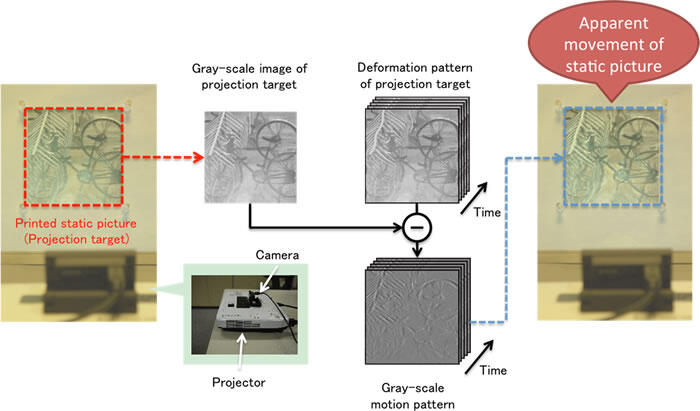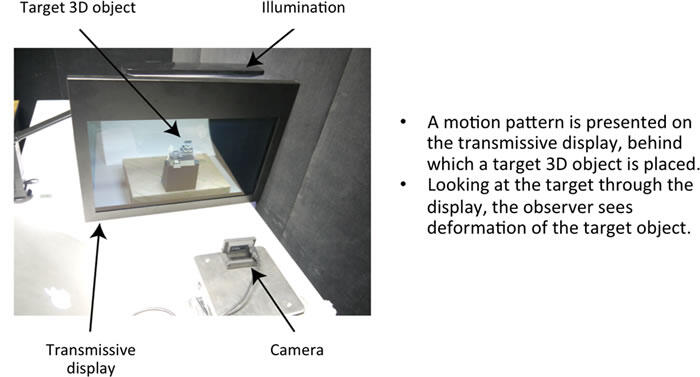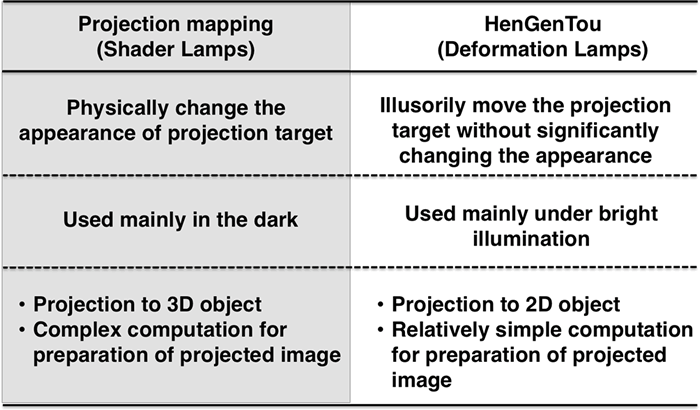Microsoft ends support for Internet Explorer on June 16, 2022.
We recommend using one of the browsers listed below.
- Microsoft Edge(Latest version)
- Mozilla Firefox(Latest version)
- Google Chrome(Latest version)
- Apple Safari(Latest version)
Please contact your browser provider for download and installation instructions.
February 17, 2015
HenGenTou (Deformation Lamps): A magical lighting system to produce illusory movements in static photos and paintings
NTT (Chiyoda-ku, Tokyo; Hiroo Unoura, CEO) has developed a new light projection technique named 'HenGenTou'(Deformation Lamps), which can add a variety of realistic movement impressions to static objects. Based on an illusion-based animation technique, HenGenTou produces completely novel visual experiences wherein physically static objects appear to move, deform, or flutter. Given its ability to provide original dynamic impressions with traditional printed photos, painted pictures and written texts, HenGenTou has applications in a wide range of fields, including advertising, interior design, art, and entertainment.
Background
"What is happening? Trees in a landscape oil painting are fluttering in the wind, and a man in a portrait suddenly starts speaking. This cannot be real." What if there were some way to produce such fantastic experiences.
A promising method may be projection mapping, a cutting-edge technology that can effectively changes visual impressions of a real object, by way of projecting a well-designed pattern onto the object's surface as a screen. Conventional projection mapping techniques, however, cannot produce movements of static objects per se, since they "paint" a new color and texture on the object's surface without preserving the original surface's appearance. In addition, although the goal of conventional projection mapping is to produce a physically correct image on the object's surface, it seems theoretically impossible to make a static picture move in a physically correct way only by image projection.
Achievement
NTT Communication Science Laboratories has developed a novel type of projection mapping named 'HenGenTou' (Deformation Lamps). HenGenTou can add a variety of dynamic impressions ranging from natural liquid flows to facial expressions to a printed image or other static materials. This capability is a result of our long-term scientific research on human information processing, in particular visual processing for natural movements.
HenGenTou makes use of visual illusions to add a movie-like dynamic appearance to a two-dimensional (2D) static object, such as fluttering flames and blowing wind. It can apparently do this even for three-dimensional (3D) objects, although the viewing condition is restricted.
Future plan
Since HenGenTou can broaden the expressiveness and increase the salience of almost any static object, it will provide a new methodology for image expression in a wide range of fields.
(1)Advertising
HenGenTou can add motion impressions to static signage, such as a printed poster or a hand-written signboard, to emphasize the main message of an advertisement.
(2)Interior design
HenGenTou can induce illusory movements on the wall or floor and produce a variety of visual effects in rooms: e.g., an undulating water flow or rising heat waves.
(3)Art and entertainment
HenGenTou can animate printed characters to make them look much more resplendent or more bizzare than the original static ones. While HenGenTou is good at adding motion impressions, conventional projection mapping is good at changing the color and texture of 3D objects. Using HenGenTou in combination with the conventional technique, artists and creators can produce novel material expressions that have never been seen before.
Examples
URL of demo movie: https://www.youtube.com/watch?v=wIHzWJm5398
- *This URL is an external site.
(1)Animation of 2D static pictures
HenGenTou can add realistic motion impressions to photographs, paintings, and walls and produce visual experiences that no one has ever had before.
- Printed flames fluttering in the wind.
- A man in a portrait changing his expression.
 Figure 1. Basic HenGenTou system
Figure 1. Basic HenGenTou system
(2)Animation of 3D static objects
Our technique can be applied to 3D objects. For complex 3D objects to which applying projection is difficult, superimposing motion with a transmissive LCD is a promising alternative.
 Figure 2. Deformation of a 3D object using transmissive display
Figure 2. Deformation of a 3D object using transmissive display
Technical issues
By projection, HenGenTou adds only a gray-scale motion pattern to a static color picture. Since the color pattern of the picture does not move, the resulting pattern is an incorrect pattern containing many inconsistencies. However, it appears to be a correct colorful movie to human observers.
Reason
The human brain analyzes an input image separately for color, form, and motion components, and then binds them together into a coherent visual representation. When a person views the pattern produced by HenGenTou, the brain receives color and form information from the static picture, but it receives motion information from the projected pattern. Since the color and form components are stationary, they are spatially misaligned with the motion component. However, when the brain binds color, form, and motion to restore a coherent visual scene, it automatically corrects small misalignments across visual attributes. Thanks to this correction process, human observers perceive the pattern produced by HenGenTou as if the color and form components of the static picture are moving along with the projected monochrome movements. The basic idea of HenGenTou arose from the long-term investigation of human visual perception of motion and material at NTT Communication Science Laboratories.
 Figure 3. Perceptual mechanism underlying HenGenTou
Figure 3. Perceptual mechanism underlying HenGenTou
Comparison with conventional projection mapping
A representative projection mapping technique, known as Shaper Lamps, projects a pattern that completely alters the original object's appearance. On the other hand, HenGenTou only adds image movements while keeping the original appearance almost intact. While Shader Lamps is mainly used under dark illumination where the projected target is not plainly visible, HenGenTou is mainly used under bright illumination where the projected target is naturally visible. Since Shader Lamps produces a physically correct appearance on the surface of 3D objects, it requires complex CG-based computation for rendering the projected image. On the other hand, since HenGenTou produces perceptually acceptable appearances on 2D surfaces, the computation for rendering the projected image is not nearly as complex. As such, HenGenTou can produce visual experiences different from those produced by conventional projection mapping using a much simpler algorithm.
 Table 1. Comparison of conventional projection mapping and HenGenTou
Table 1. Comparison of conventional projection mapping and HenGenTou
Contacts details for inquiries
Nippon Telegraph and Telephone Corporation
Science and Core Technology Laboratory Group, Public Relations
email a-info@lab.ntt.co.jp
TEL 046-240-5157
Information is current as of the date of issue of the individual press release.
Please be advised that information may be outdated after that point.
NTT STORY
WEB media that thinks about the future with NTT











